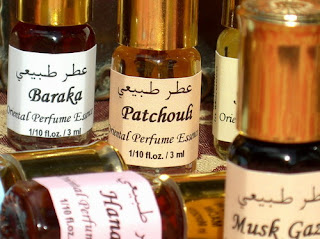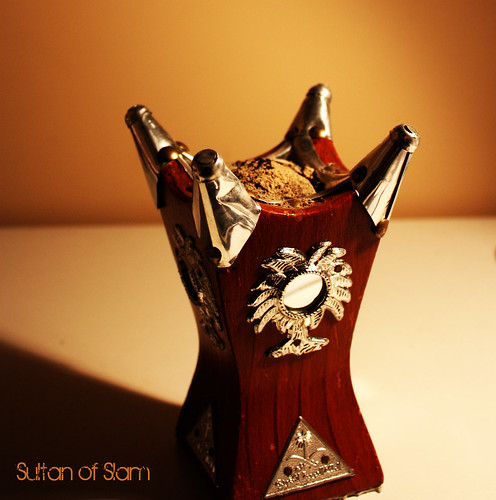
Fragrance is a fleeting thing.
Fleeting, moving, ever-changing and not quite tangible – this art form demonstrates the passage of time in the most profound way and forces us to “live in the moment” so to speak. Even music, which acts in a similar way, can be re-created and re-lived by most people, simply by humming the tune.
The notion of something so fleeting having a “structure” always struck me as odd. I’m puzzled by it even more than how it is used in reference to music. I still remember that one piano lesson to which my stepfather unusually accompanied me. I was studying a sonatina by Mozart. My teacher and him were keenly trying to explain to me the concept of “symmetry” in classical music and how it is parallel to symmetric visual art. I was trying hard to grasp it, until I gave in and just pretended that I got it (incidentally, my stepfather, a painter, was obsessed with symmetry art all his life; which is perhaps why he always thought that if something goes wrong in his life, it should also go badly for everyone else – just for the sake of making things nice and even).
Things that pass through time work differently than still images or sculptures. The only way symmetry can be created is by perceiving the present and the future as relating to the past; being able to recreate the past while experiencing the present, and having some kind of anticipation of the future, based on a gestalt that was molded in the brain (although could be proven completely wrong).
Western perfumery is a relatively new invention; and like many things that travel from the East to the West (perfumery was developed in the Middle East and in Asia before anywhere else in the world) – it has taken a path of its own, making some things far more advanced (technology-wise), yet remaining rigid in many other ways. The “pyramid” structure that is so popularly used to explain and describe the evolution and so-called “structure” of perfume, although shaped like a pyramid, has nothing to do with Egypt (the culture that developed the first most complex perfume in the form of Kyphi incense); and says very little about a perfume’s behaviour and characteristics. The breakdown of notes into three stages is rather random, too. Even perfumes that have been designed to fit this paradigm, there are many more stages than that.
Ancient perfumery did not have “structure” in the sense that Western perfumery perceives its art form now. Egyptian perfumes, Asian perfumes, Arabian perfumes and Indian perfumes are created with completely different principles in mind. I am still trying to figure out what that might be, as literature in English barely exists on the subject; and I doubt if there is any official literature either. In India, perfumery is a family secret that is passed from father to son, and outsiders are rarely privy to this knowledge. What we do know is, that traditional Indian perfumes, which are called “attars” are created in a completely different technique and approach than Western perfumery. Attar is an Arabic word, which refers to the spirit or “ether” of the plants, i.e. the essential oil. The word “attar” or its permutation “otto” is often used to describe rose essential oil (in perfumery literature, it is referred to as “rose otto” or “attar of rose”).
Indian attars differ from modern perfumery on several levels. The most obvious are the technical ones:
1) The formulation process takes place with the raw materials prior to distillation. The spices, woods, resins, herbs, flowers and so on are measured and blended together in their raw state and only than placed in the still. I can only guess that the principles of blending these perfumes may be in tune with Ayurveda or spiritual and religious principles such as the chakra systems.
2) Sandalwood oil forms the base or “carrier” for Indian attars (much in the same vein that rather that alcohol or a fixed oil are used in modern perfumery). Thus, even the simplest attar will contain at least two botanicals. For example: Attar Motia is made from jasmine sambac (Jasminum sambac) which is distilled into the sandalwood (Santalum album) essential oil. Sandalwood oil is one of the few oils that can be worn neat on the skin, it has a rich, viscous and sensual teqture, and a very subtle aroma that deepens the perfume of single flowers and adds fixative qualities to the attar.
3) Last but not least, unlike modern Western perfumers, the Indian perfumers actually distill their own essence. They are in touch with the plants in their original raw state, and at times even pick them from the wild. Using a light, portable copper still, the perfumer can carry it on his back while entering the wilderness to collect flowers in their blooming season, be it from the coast, the jungle or the pond (for example: lotus and water lily have to be harvested while the perfumer goes .

The roots of modern Western perfumery are in alchemy – an art and a science that has began as early as ancient Egypt and later on re-discovered by the Muslims in the Middle Ages. The Arabic and Muslim alchemists further developed this esoteric mysticism into the scientific realms of chemistry and medicine as known today. The three principles of the Western “pyramid structure” actually correspond to the three alchemical principals – the “Tria Prima” which make up all matter: sulfur, mercury and salt.

Mercury is a passive principle, yet it is also very dynamic, which makes it a little more confusing to grasp, just as it is difficult to catch quicksilver, being both a metal and a liquid. It is associated with Luna, the feminine archetype; as well as the element of air or with water, cold and moisture. It is the most volatile. It also represents the human soul. The alchemical symbol is identical to that for the planet mercury: a circle with a crescent atop it, which does not represent the moon, but the winged messenger (the Greek god Hermes, aka as Mercury to the Romans). I find this interesting: being so volatile makes it transcend above matter and connect to the spiritual world. The top notes in a perfume have very much the role of “Mercury”: they are the most volatile, fleeting and difficult to grasp. Yet they are what gives the perfume vibrancy and are the first contact we have with the perfume. In a way, they are the “messenger”, the medium rather than the message... They invite us in to further explore what the perfume has to say.
 Sulphur (the original spelling for “sulfur”) is the active principle, “The Red King”, Sol (the sun), associated with the element of fire – heat and dryness. The symbol for sulphur is a fire triangle mounted on the earth cross. It has a masculine and expansive force, and creates evaporation and dissolution. Within the aesthetics of Western perfumery – the heart notes are what make perfume a true perfume.
Sulphur (the original spelling for “sulfur”) is the active principle, “The Red King”, Sol (the sun), associated with the element of fire – heat and dryness. The symbol for sulphur is a fire triangle mounted on the earth cross. It has a masculine and expansive force, and creates evaporation and dissolution. Within the aesthetics of Western perfumery – the heart notes are what make perfume a true perfume.
Salt is the stable, solid foundation. It is analogous to the physical body and to the earth. The alchemical symbol is of a circle with a horizontal line dividing between above and below; very similar to the symbol of the planet earth (a circle with a complete cross in the middle). It only is missing a divine force from above (a vertical line) to make it complete and complex with  potential for life, like the earth. The base notes in the perfume are like salt: they provide the stability and the foundation for the perfume. They are what gives it a form. Being so less volatile makes the reliable and solid like salt. And with the added elements of the top notes and the heart notes, a dynamic entity is created, with vitality and movement. And of course the final and most important element which makes perfume complete and alive is the person wearing it.
potential for life, like the earth. The base notes in the perfume are like salt: they provide the stability and the foundation for the perfume. They are what gives it a form. Being so less volatile makes the reliable and solid like salt. And with the added elements of the top notes and the heart notes, a dynamic entity is created, with vitality and movement. And of course the final and most important element which makes perfume complete and alive is the person wearing it.
Western perfumes were created with that philosophy, aesthetic values and “structure” in mind for hundreds of years, until commercialism got in the way, so to speak. In the early 1990’s, perfumes began to create linear perfumes. Sophia Grojsman’s Trésor (1990) was especially groundbreaking because it used very few ingredients to bring forth an abstract rose, instead of using many complex bases with hundreds of ingredients. “It is like drawing a flower—at first, you draw a heart and then you start by painting petals” – described Grojsman her process in an 2006 interview to Bois de Jasmine. Her approach was revolutionary at the time, and her perfumes have an unmistakable style – bold yet tender, focused (usually around rose) yet dynamic.
Trésor was just one of the first perfumes signaling the beginning of a trend of linear perfumes – it was not only simple (rose, vanilla and peach seem to be the main three notes), but also had very little in the way of evolution. But the first linear perfume per-se, created solely with that intention is Toacde (Maurice Roucel, 1994, for Rochas), where rose, magnolia, vanilla and a flat freshness of bergamot persists through the entire composition. Poême 1995 Jacques Cavallier was also an epitome of linear thinking.
Linear perfumes change very little if at all from start to finish, disregarding the element of time and replacing it with a static sculpture of molecules hanging in mid-air, and avoiding any relationship with the wearer’s skin.
It’s interesting that the first linear scents were so rosy… But the first ones were at least interesting. They were soon replaced by a humdrum of gourmands (a-la Angel, which also does not change much with its patchouli and caramel persistence) and clean, paired-down musk accords which are at times nothing but an insult to the consumer’s olfactory intelligence. While the first compositions seemed to have poise and elegance and purpose or thought behind them, the current state of affairs is that linear scents were adopted by the mainstream perfume industry as means to make more sales: what’s the point of having top notes if they disappear after half and hour or less? What’s the point of having any evolution at all, if the customer needs to spend days in sampling, experiencing the scent and making up their minds? It’s easiest to create something 100% homogenous, that will not be affected by factors as skin chemistry and just remain as the “trailer” (i.e.: the scent strip or fabric ribbon) promised.
Another confusing structural approach was presented in Allure (Chanel’s house perfumery, Jacques Polge). When it was launched in 1996, it promised a revolutionary structure where “facets” rather than an evolution from top to heart to base:
“No more top, middle and base notes. ALLURE dispenses with these traditional notions to embrace a multi-faceted approach. There are six of these facets to be exact, which overlap and harmonise with each other, no single facet becoming dominant over the others…”
(from Chanel's website).
The six facets were illustrated by a hexagon, divided into 6 triangles:
1) Fresh : Citron note.
2) Fruity : Sicilian Mandarin.
3) Timeless Floral : May Rose, Oriental Jasmine.
4) Imaginary Floral : Magnolia accord, Honeysuckle accord, Water lily accord.
5) Woody : Haitian Vetiver.
6) Oriental : Vanilla from Réunion.
A quick glance at this makes one wonder. After all: citron and mandarin (Sicilian or otherwise) are both top notes. The florals in facets 3 and 4 are all heart notes; and lastly, vetiver and vanilla (facets 5 and 6) are both base notes. What are they trying to say? That the perfume progresses gradually through its various notes (which is true to some extent)? That it revolves like a circle between those various facets? There is only one way to tell, which is to wear it and try it for yourself. I experience it mostly as a linear scent. There is none of the complex evolution that can be found in other Chanel perfumes (say, Bois des Îles).
 Recently, I stumbled upon CrazyLibellule and the Poppies website, where the “Etoile Olfactive” (olfactory star) is used to illustrate the different notes. Which kind of olfactory evolution would this be? An explosion, perhaps?
Recently, I stumbled upon CrazyLibellule and the Poppies website, where the “Etoile Olfactive” (olfactory star) is used to illustrate the different notes. Which kind of olfactory evolution would this be? An explosion, perhaps?
The more I think about it, the more confused I become. And than I get back to my original view and perception of perfume: an art form that takes place in time, rather than space. If it has any structure it would be similar to that in a music, film or storytelling. And the perfumes that I want to create, wear, smell and experience are those that tell a story. And stories have a beginning, middle and an end.


















